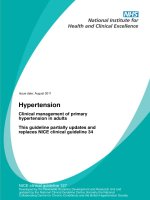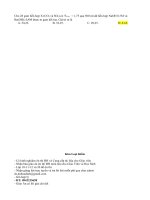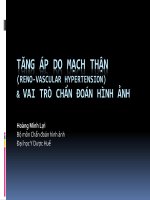Resistant hypertension 2016
Bạn đang xem bản rút gọn của tài liệu. Xem và tải ngay bản đầy đủ của tài liệu tại đây (2.92 MB, 122 trang )
Practical Case Studies in Hypertension Management
Series Editor: Giuliano Tocci
Massimo Salvetti
Resistant
Hypertension
Practical Case Studies in
Hypertension Management
Series editor
Giuliano Tocci
Rome, Italy
The aim of the book series “Practical Case Studies in
Hypertension Management” is to provide physicians who
treat hypertensive patients having different cardiovascular
risk profiles with an easy-to-access tool that will enhance
their clinical practice, improve average blood pressure control, and reduce the incidence of major hypertension-related
complications. To achieve these ambitious goals, each volume
presents and discusses a set of paradigmatic clinical cases
relating to different scenarios in hypertension. These cases
will serve as a basis for analyzing best practice and highlight
problems in implementing the recommendations contained
in international guidelines regarding diagnosis and treatment.
While the available guidelines have contributed significantly
in improving the diagnostic process, cardiovascular risk stratification, and therapeutic management in patients with essential hypertension, they are of relatively limited help to
physicians in daily clinical practice when approaching individual patients with hypertension, and this is particularly true
when choosing among different drug classes and molecules.
By discussing exemplary clinical cases that may better represent clinical practice in a “real world” setting, this series will
assist physicians in selecting the best diagnostic and therapeutic options.
More information about this series at inger.
com/series/13624
Massimo Salvetti
Resistant Hypertension
Prof. Massimo Salvetti
ASST Spedali Civili di Brescia
Clinica Medica-University of Brescia
Brescia, Italy
ISSN 2364-6632
ISSN 2364-6640 (electronic)
Practical Case Studies in Hypertension Management
ISBN 978-3-319-30636-0
ISBN 978-3-319-30637-7 (eBook)
DOI 10.1007/978-3-319-30637-7
Library of Congress Control Number: 2016942889
© Springer International Publishing Switzerland 2016
This work is subject to copyright. All rights are reserved by the Publisher,
whether the whole or part of the material is concerned, specifically the rights of
translation, reprinting, reuse of illustrations, recitation, broadcasting, reproduction on microfilms or in any other physical way, and transmission or information
storage and retrieval, electronic adaptation, computer software, or by similar or
dissimilar methodology now known or hereafter developed.
The use of general descriptive names, registered names, trademarks, service
marks, etc. in this publication does not imply, even in the absence of a specific
statement, that such names are exempt from the relevant protective laws and
regulations and therefore free for general use.
The publisher, the authors and the editors are safe to assume that the advice and
information in this book are believed to be true and accurate at the date of publication. Neither the publisher nor the authors or the editors give a warranty,
express or implied, with respect to the material contained herein or for any errors
or omissions that may have been made.
Printed on acid-free paper
This Springer imprint is published by Springer Nature
The registered company is Springer International Publishing AG Switzerland
Foreword
Resistant hypertension is a complex clinical condition in
which blood pressure levels remained above the recommended targets, despite optimal pharmacological and nonpharmacological treatment. Nowadays, several diagnostic
criteria and different therapeutic strategies have been proposed and tested in various clinical settings and study
population.
All of these definitions substantially embraced the following aspects: (1) proper assessment of blood pressure levels
according to recommendations from international guidelines
for measuring blood pressure, (2) optimization of lifestyle
changes, (3) exclusion of secondary causes of hypertension,
and (4) use of combination therapies at adequate dosages
and compounds. Comprehensive and accurate diagnostic
evaluation of the potential causes of resistant hypertension
represents a crucial aspect for the clinical management of
these patients, since several studies have demonstrated that
proper lifestyle changes and drug treatment optimization
may improve blood pressure control rates and promote the
achievement of the recommended blood pressure targets in
the majority of patients with apparently resistant hypertension. On the other hand, patients with true resistant hypertension remained at higher risk of major cardiovascular and
cerebrovascular complications compared to patients with
v
vi
Foreword
essential hypertension. As a consequence, these patients with
difficult-to-treat hypertension may heavily contribute to the
global burden of hypertension-related complications.
In this volume of Practical Case Studies in Hypertension
Management, the clinical management of paradigmatic cases
of patients with resistant hypertension is discussed, focusing
on the different diagnostic criteria currently available for
properly identifying these high-risk patients, as well as on the
different therapeutic options currently recommended for
improving blood pressure control and reducing the risk of
hypertension-related morbidity and mortality.
Department of Clinical
and Molecular Medicine
University of Rome Sapienza
St. Andrea Hospital
Rome, Italy
Giuliano Tocci
Contents
Clinical Case 1 Adult Patient with True Resistant
Hypertension .......................................................................
1.1 Clinical Case Presentation ........................................
Family History ............................................................
Clinical History ..........................................................
Physical Examination ................................................
Haematological Profile .............................................
Blood Pressure Profile ..............................................
12-Lead Electrocardiogram ......................................
Current Treatment .....................................................
Diagnosis.....................................................................
Treatment Evaluation................................................
Prescriptions ...............................................................
1.2 Follow-Up (Visit 1) at 5 Weeks ................................
Physical Examination ................................................
Blood Pressure Profile ..............................................
Current Treatment .....................................................
Aldosterone, Renin and Cortisol Levels ................
Echocardiogram .........................................................
Ultrasound Scan of the Carotid Arteries,
with Echo Colour Doppler .......................................
Diagnosis.....................................................................
Treatment Evaluation................................................
Prescriptions ...............................................................
1.3 Follow-Up (Visit 2) at 3 Months ..............................
Physical Examination ................................................
1
1
2
2
2
3
3
4
4
5
6
6
7
7
7
7
7
8
8
9
10
10
10
11
vii
viii
Contents
Blood Pressure Profile ..............................................
Current Treatment .....................................................
Treatment Evaluation................................................
Prescriptions ...............................................................
1.4 Follow-Up (Visit 2) at 1 Year ...................................
Physical Examination ................................................
Blood Pressure Profile ..............................................
12-Lead Electrocardiogram ......................................
Current Treatment .....................................................
Treatment Evaluation................................................
Prescriptions ...............................................................
1.5 Discussion ...................................................................
References ...........................................................................
Clinical Case 2 Adult Patient with Pseudo-Resistant
Hypertension: High Blood Pressure Induced
by Exogenous Substances..................................................
2.1 Clinical Case Presentation ........................................
Family History ............................................................
Clinical History ..........................................................
Physical Examination ................................................
Haematological Profile .............................................
Blood Pressure Profile ..............................................
12-Lead Electrocardiogram ......................................
Fundoscopic Examination ........................................
Current Treatment .....................................................
Diagnosis.....................................................................
Ultrasound Evaluation of the Carotid Arteries.....
Treatment Evaluation................................................
Prescriptions ...............................................................
2.2 Follow-Up (Visit 1) at the Endocrinologist’s
Office (1 Day After the Echocardiogram
and After Initiation of Doxazosin) ..........................
Physical Examination ................................................
Current Treatment .....................................................
Treatment Evaluation................................................
Prescriptions ...............................................................
2.3 Follow-Up (Visit 2) (4 Days After the
Echocardiogram) .......................................................
Physical Examination ................................................
11
11
11
11
12
12
12
12
13
13
13
13
16
19
19
20
20
20
20
21
22
22
22
22
25
26
26
28
28
28
28
28
29
29
Contents
ix
Blood Pressure Profile ..............................................
Current Treatment .....................................................
Treatment Evaluation................................................
Diagnosis.....................................................................
Prescriptions ...............................................................
2.4 Follow-Up (Visit 3, Final Visit) at 1 Month ............
Blood Pressure Profile ..............................................
12-Lead Electrocardiogram ......................................
Current Treatment .....................................................
Treatment Evaluation................................................
Prescriptions ...............................................................
Diagnosis.....................................................................
2.5 Discussion ...................................................................
References ...........................................................................
29
29
29
30
30
30
31
31
31
31
31
31
32
35
Clinical Case 3 Adult Patient with Pseudo-Resistant
Hypertension: Low Adherence .........................................
3.1 Clinical Case Presentation ........................................
Family History ............................................................
Clinical History ..........................................................
Physical Examination ................................................
Haematological Profile .............................................
Blood Pressure Profile ..............................................
12-Lead Electrocardiogram ......................................
Echocardiogram .........................................................
Vascular Ultrasound ..................................................
Arterial Stiffness ........................................................
Current Treatment .....................................................
Global Cardiovascular Risk Stratification..............
Workup........................................................................
Treatment Evaluation................................................
Prescriptions ...............................................................
3.2 Follow-Up (Visit 1) at 4 Weeks ................................
Physical Examination ................................................
Blood Pressure Profile ..............................................
Current Treatment .....................................................
Aldosterone, Renin and Cortisol Levels ................
Diagnosis.....................................................................
Diagnosis.....................................................................
Treatment Evaluation................................................
37
37
37
38
38
39
39
40
41
41
41
42
43
43
44
44
44
44
45
45
45
45
46
46
x
Contents
Prescribed Treatment ................................................
Prescriptions ...............................................................
3.3 Follow-Up (Visit 2) at 3 Months ..............................
Physical Examination ................................................
Blood Pressure Profile ..............................................
Current Treatment .....................................................
Treatment Evaluation................................................
Prescriptions ...............................................................
3.4 Follow-Up (Visit 2) at 1 Year ...................................
Physical Examination ................................................
Haematological Profile .............................................
Blood Pressure Profile ..............................................
Current Treatment .....................................................
Treatment Evaluation................................................
Ambulatory Blood Pressure Monitoring ................
Prescriptions ...............................................................
3.5 Discussion ...................................................................
References ...........................................................................
46
46
47
47
47
48
48
48
48
48
49
49
49
49
50
50
51
54
Clinical Case 4 Adult Patient with Pseudo-Resistant
Hypertension: Drug Intolerance.......................................
4.1 Clinical Case Presentation ........................................
Family History ............................................................
Clinical History ..........................................................
Physical Examination ................................................
Haematological Profile .............................................
Blood Pressure Profile ..............................................
12-Lead Electrocardiogram ......................................
Current Treatment .....................................................
Diagnosis.....................................................................
Treatment Evaluation................................................
Prescriptions ...............................................................
4.2 Follow-Up (Visit 1) at 6 Weeks ................................
Physical Examination ................................................
Blood Pressure Profile ..............................................
Current Treatment .....................................................
Microalbuminuria ......................................................
Echocardiogram .........................................................
55
55
56
56
57
57
58
58
59
59
60
60
61
61
62
62
62
62
Contents
xi
Ultrasound Evaluation of the Carotid Arteries.....
Diagnosis.....................................................................
Treatment Evaluation................................................
Prescriptions ...............................................................
4.3 Follow-Up (Visit 2) After Further 4 Weeks ............
Physical Examination ................................................
Blood Pressure Profile ..............................................
Ambulatory Blood Pressure Monitoring ................
Renal Function Parameters ......................................
Current Treatment .....................................................
Treatment Evaluation................................................
Prescriptions ...............................................................
4.4 Follow-Up (Visit 3) at 3 Months ..............................
Physical Examination ................................................
Blood Pressure Profile ..............................................
Renal Function Parameters ......................................
12-Lead Electrocardiogram ......................................
Current Treatment .....................................................
Treatment Evaluation................................................
Prescriptions ...............................................................
4.5 Discussion ...................................................................
References ...........................................................................
63
65
66
66
67
67
67
67
68
68
68
69
69
69
70
70
70
70
70
70
71
73
Clinical Case 5 Adult Patient with Pseudo-Resistant
Hypertension: Spurious Resistant Hypertension ...........
5.1 Clinical Case Presentation ........................................
Family History ............................................................
Clinical History ..........................................................
Physical Examination ................................................
Haematological Profile .............................................
Blood Pressure Profile ..............................................
12-Lead Electrocardiogram ......................................
Current Treatment .....................................................
Global Cardiovascular Risk Stratification..............
Workup........................................................................
Treatment Evaluation................................................
Treatment Prescribed ................................................
Prescriptions ...............................................................
75
75
75
76
77
77
77
78
78
79
79
79
80
80
xii
Contents
5.2 Follow-Up (Visit 1) at 6 Weeks ................................
Physical Examination ................................................
Blood Pressure Profile ..............................................
Current Treatment .....................................................
Haematological Profile .............................................
Echocardiogram .........................................................
Carotid-Femoral Pulse Wave Velocity ....................
Holter ECG ................................................................
Treatment Evaluation................................................
Prescriptions ...............................................................
5.3 Follow-Up (Visit 2) at 12 Weeks ..............................
Physical Examination ................................................
Current Treatment .....................................................
Blood Pressure Profile ..............................................
Current Treatment .....................................................
Treatment Evaluation................................................
Treatment Prescribed ................................................
Prescriptions ...............................................................
5.4 Follow-Up (Visit 3) at 6 Months ..............................
Physical Examination ................................................
Blood Pressure Profile ..............................................
Current Treatment .....................................................
Treatment Evaluation................................................
Treatment Prescribed ................................................
Prescriptions ...............................................................
5.5 Discussion ...................................................................
References ...........................................................................
80
80
81
81
81
81
82
82
82
83
83
83
83
84
85
85
85
85
85
86
86
86
86
86
87
87
89
Clinical Case 6 Adult Patient with Resistant
Hypertension Secondary to Comorbidities .....................
6.1 Clinical Case Presentation ........................................
Family History ............................................................
Clinical History ..........................................................
Physical Examination ................................................
Haematological Profile .............................................
Blood Pressure Profile ..............................................
12-Lead Electrocardiogram ......................................
Vascular Ultrasound ..................................................
Current Treatment .....................................................
91
91
91
92
93
93
94
94
94
95
Contents
xiii
Global Cardiovascular Risk Stratification..............
Workup........................................................................
Treatment Evaluation................................................
Treatment Prescribed ................................................
Prescriptions ...............................................................
6.2 Follow-Up (Visit 1) at 4 Weeks ................................
Physical Examination ................................................
Blood Pressure Profile ..............................................
Current Treatment .....................................................
Haematological Profile .............................................
Echocardiogram .........................................................
Diagnosis.....................................................................
Treatment Evaluation................................................
Treatment Prescribed ................................................
Prescriptions ...............................................................
6.3 Follow-Up (Visit 2) at 2 Months ..............................
Physical Examination ................................................
Blood Pressure Profile ..............................................
Current Treatment .....................................................
Treatment Evaluation................................................
Treatment Prescribed ................................................
Prescriptions ...............................................................
6.4 Follow-Up (Visit 3) at 3 Months ..............................
Physical Examination ................................................
Haematological Profile .............................................
Blood Pressure Profile ..............................................
Current Treatment .....................................................
Treatment Evaluation................................................
Treatment Prescribed ................................................
Prescriptions ...............................................................
6.5 Follow-Up (Visit 4) at 6 Months ..............................
Physical Examination ................................................
Blood Pressure Profile ..............................................
Current Treatment .....................................................
Treatment Evaluation................................................
Treatment Prescribed ................................................
Prescriptions ...............................................................
6.6 Discussion ...................................................................
References ...........................................................................
96
96
96
96
97
97
97
98
99
99
99
100
100
100
101
101
101
102
102
102
102
102
103
103
103
104
104
104
104
104
105
105
105
105
106
106
106
106
109
Clinical Case 1
Adult Patient with True Resistant
Hypertension
1.1
Clinical Case Presentation
M. B., a 54-year-old Caucasian female, housemaid, was seen
at an office visit for uncontrolled hypertension.
When she was 49, age at which she became menopausal,
she was diagnosed as having grade 2 arterial hypertension.
She had been initially treated with a beta blocker,
bisoprolol 5 mg OD, and after a few months, an ACE
inhibitor had been added (ramipril 5 mg OD) by the general practitioner.
In the following months, the patient was asymptomatic
but, according to the patient’s description, blood pressure
control was not satisfactory.
After 1 year antihypertensive treatment was changed due
to poor blood pressure control, and the dose of the ACE
inhibitor and of the beta blocker was increased by the general
practitioner: ramipril 10 mg once daily and bisoprolol 10 mg
were prescribed.
In the following months, blood pressure control was
defined as “satisfactory” by the patient.
At the beginning of this year, the patient was seen by the
general practitioner for recurrent mild headaches. At the
doctor’s office, blood pressure was >150/100 mmHg, and
hydrochlorothiazide was added, at the dosage of 25 mg once
daily.
© Springer International Publishing Switzerland 2016
M. Salvetti, Resistant Hypertension, Practical
Case Studies in Hypertension Management,
DOI 10.1007/978-3-319-30637-7_1
1
2
Clinical Case 1.
Adult Patient with True Resistant…
Family History
Her mother, 78 years old, is hypercholesterolemic. Her father
died at the age of 80 for hemorrhagic stroke. She suffered
hypertension since the age of 50. She has one brother (50 years
old), who is on treatment with statins for hypercholesterolemia, and one sister (51 years old), who is healthy.
She lives with her husband, who is in good health, and they
have one daughter.
Clinical History
She has never smoked cigarettes. She does not drink alcohol
and has sedentary habits.
She is hypercholesterolemic and is taking simvastatin
(20 mg once daily).
She has no other known cardiovascular risk factor, associated clinical conditions or non-cardiovascular diseases.
Physical Examination
•
•
•
•
•
•
•
•
•
•
•
•
Weight: 86 kg
Height: 166 cm
Body mass index (BMI): 31.2 kg/m2
Waist circumference: 96 cm
Respiration: 12/min
Heart: grade 1 systolic murmur at the apex
Resting pulse: regular rhythm with normal heart rate
(66 beats/min)
Carotid arteries: no murmurs
Femoral and foot arteries: palpable
Clear lungs
No lower extremity oedema
The remainder of the examination was normal
1.1
Clinical Case Presentation
3
Haematological Profile
•
•
•
•
•
•
•
•
•
•
•
Haemoglobin: 14.0 g/dL
Haematocrit: 44 %
Fasting plasma glucose: 96 mg/dL
Fasting lipids: total cholesterol 172 mg/dL; HDL 44 mg/
dL; triglycerides 146 mg/dL (LDL, Friedewald formula:
99 mg/dL),
Electrolytes: sodium, 144 mEq/L; potassium, 3.9 mEq/L
Serum Uric Acid: 4.9 mg/dL
Renal function: creatinine, 0.9 mg/dL; estimated glomerular filtration rate (eGFR) (EPI formula: 73 mL/min/1.73 m2)
Urine analysis (dipstick): normal
Urinary albumin excretion: albumin/creatinine ratio 18 mg/g
Normal liver function tests
Normal serum TSH
Blood Pressure Profile
Mrs. M.B. was taking measurements of blood pressure values
at home on a daily basis, mainly in the afternoon (single
measurement).
• Home BP was, on average, 150–155/100 mmHg.
• Office sitting BP: 160/106 mmHg (right arm); 158/104 mmHg
(left arm).
• Standing BP: 152/106 mmHg at 1 min.
• 24-h BP: 150/99 mmHg; HR, 63 bpm.
• Daytime BP: 154/101 mmHg; HR, 65 bpm.
• Night-time BP: 143/95 mmHg; HR, 58 bpm.
• The 24-h blood pressure profile may be defined as a “nondipping pattern” (day/night SBP drop was 7 %). Blood
pressure variability was not increased.
The 24-h ambulatory blood pressure profile is illustrated
in Fig. 1.1.
4
Clinical Case 1.
Adult Patient with True Resistant…
Figure 1.1 24-Hour ambulatory blood pressure monitoring
12-Lead Electrocardiogram
The electrocardiogram showed sinus rhythm, without evidence of left ventricular hypertrophy (Cornell voltage
<3.5 mV, Cornell product <244 mV*ms, r aVL <1.1 mV).
The repolarization was normal and, in particular, there
were no signs of “strain” (Fig. 1.2).
During the visit her husband was asked about the quality
of sleep of the partner (snoring, witnessed apneas, restless
sleep), and, at the end of the interview, sleep apnoea was
judged unlikely in this patient.
Current Treatment
Ramipril 10 mg once daily (h 8:00); bisoprolol 10 mg once
daily (h 08.00); hydrochlorothiazide 25 mg (h 8:00).
1.1
Clinical Case Presentation
5
Figure 1.2 (a, b) Electrocardiogram
Diagnosis
– Resistant hypertension: arterial hypertension (grade 2)
with unsatisfactory BP control despite combination therapy with three drugs
– Central obesity (grade 1, BMI 31)
– Hypercholesterolemia
– Sedentary habits
– No evidence of hypertension-related organ damage or
associated clinical conditions.
Which is the global cardiovascular risk profile in this
patient?
Possible answers are:
1.
2.
3.
4.
Low
Medium
Moderate to high
High
6
Clinical Case 1.
Adult Patient with True Resistant…
According to ESH ESC 2013 Guidelines CV, added risk is
moderate to high [1].
Which is the best therapeutic option in this patient?
Possible answers are:
1.
2.
3.
4.
Add another drug.
Renal denervation.
Reinforce lifestyle changes.
Reinforce lifestyle changes and exclude secondary
hypertension.
Treatment Evaluation
✓ Ongoing treatment with ACE inhibitor, beta blocker and
diuretic was temporarily stopped due to possible interference with aldosterone and renin levels.
✓ Verapamil slow release 120 twice daily was started.
✓ Doxazosin 4 mg OD, in the evening, was started.
Prescriptions
✓ Sampling for plasma renin activity and aldosterone was
scheduled, after at least 4 weeks of wash out from the
ongoing treatment.
✓ Dosage of 24 h urinary cortisol.
✓ An echocardiogram was also prescribed, with the main aim
of evaluating left ventricular structure and function and
left atrial size.
✓ The patient was instructed to increase physical activity
(mild intensity, at least 4 days weekly) and to reduce
caloric and salt intake.
The patient was also advised to contact the doctor in case
of severe blood pressure elevation (grade 3 hypertension).
1.2 Follow-Up (Visit 1) at 5 Weeks
1.2
7
Follow-Up (Visit 1) at 5 Weeks
At follow-up visit the patient was fine.
She had measured her blood pressure on a daily basis, and
mean home BP values were (on average) 150/94 mmHg.
She had started mild physical activity three times per week
with initial positive effects (weight loss – 2 kg).
No adverse reactions or drug-related side effects were
reported.
Physical Examination
• Weight: 84 kg
• BMI: 30.48 kg/m2
• Resting pulse: regular rhythm with normal heart rate
(66 beats/min)
• Other clinical parameters substantially unchanged
Blood Pressure Profile
• Home BP (average): 150/94 mmHg (mean of measurements in the morning and in the evening)
• Office sitting BP: 158/98 mmHg (left arm)
• Standing BP: 152/98 mmHg (after 1 min)
Current Treatment
✓ Verapamil slow release 120 twice daily
✓ Doxazosin 4 mg OD, in the evening
Aldosterone, Renin and Cortisol Levels
•
•
•
•
Aldosterone: 140 pg/mL
Renin: 6 μUI/mL
Aldosterone/renin ratio: 2.3
Urinary cortisol: normal
8
Clinical Case 1.
Adult Patient with True Resistant…
Figure 1.3 Echocardiogram showing left ventricular hypertrophy
Echocardiogram
The echocardiogram showed normal left ventricular internal
dimensions with an increase in left ventricular mass and an
increase in relative wall thickness: left ventricular hypertrophy,
concentric type (LV mass index, 54 g/m2.7; relative wall thickness, 0.53). Preserved endocardial systolic function, reduced
midwall fractional shortening. The evaluation of Doppler indices of diastolic function with both conventional and tissue
Doppler showed impaired LV relaxation (isovolumic relaxation time 110 ms), without signs of increased LV filling pressure (E/Em 8). Left atrial size and the dimensions of the
proximal aorta were normal. Mild mitral regurgitation was
observed (+) (Fig. 1.3).
Ultrasound Scan of the Carotid Arteries,
with Echo Colour Doppler
Small plaques on the carotid bifurcations. No stenosis
(Fig. 1.4)
1.2 Follow-Up (Visit 1) at 5 Weeks
9
Figure 1.4 Echo colour Doppler of the carotid arteries
Diagnosis
Primary aldosteronism?
1. Yes
2. No
The aldosterone/renin was 2.3, which is below the suggested
thresholds (<3.7) [5], and furthermore, absolute aldosterone
levels were not elevated (<150 pg/mL); therefore, primary
aldosteronism was excluded. Urinary cortisol was also within
the normal range. Furthermore, there was no evidence of
renal artery stenosis or renal disease and there were no sleep
disturbances.
Therefore, a final diagnosis was made:
– Essential hypertension, resistant to treatment
– Grade 2, high-added cardiovascular risk
10
Clinical Case 1.
Adult Patient with True Resistant…
– Cardiac preclinical organ damage (concentric LV hypertrophy),
impaired LV diastolic relaxation preclinical vascular damage.
– Abdominal obesity
Treatment Evaluation
✓ Treatment with calcium channel blocker was maintained,
switching to a potent dihydropyridine at full dosage.
✓ A long-acting angiotensin receptor blocker was added, at
full dosage.
✓ A potent thiazide-like diuretic was added.
Prescribed Treatment
– Olmesartan 40+ amlodipine 10 mg fixed combination once
daily at 08.00 am
– Chlortalidone 25 mg once daily at 08.00 am
Prescriptions
✓ Periodical BP evaluation at home according to recommendations from current guidelines
✓ Control of renal function (high-dose diuretic and ARB)
✓ Regular physical activity and low caloric intake
1.3
Follow-Up (Visit 2) at 3 Months
At follow-up visit the patient is fine.
She is following a healthier diet and she performs regular
physical activity, three or four times per week. Her weight is
improved (− 6 kg from the first visit).
She expresses her preference for fixed (single pill) combination of antihypertensive drugs.
• Electrolytes: sodium, 144 mEq/L; potassium, 3.5 mEq/L
• Serum uric acid: 5.0 mg/dL
• Renal function: creatinine, 0.9 mg/dL; estimated glomerular
filtration rate (eGFR) (EPI formula, 70 mL/min/1.73 m2)
1.3
Follow-Up (Visit 2) at 3 Months
11
Physical Examination
•
•
•
•
•
Weight: 80 kg
BMI: 29 kg/m2
Waist circumference: 89 cm
Resting pulse: regular rhythm with 72 beats/min
Other parameters substantially unchanged
Blood Pressure Profile
• Home BP (average): 140/90 mmHg (early morning)
• Sitting BP: 148/88 mmHg (mean of three measurements, in
sitting position)
• Standing BP: 144/92 mmHg
Current Treatment
• Olmesartan 40+ amlodipine 10 mg fixed combination
once daily at 08.00 am; chlortalidone 25 mg once daily at
08.00 am
Treatment Evaluation
✓ Spironolactone 25 mg once daily was added.
✓ The combination of ARB, diuretic and calcium antagonist
was maintained.
Prescriptions
✓ Periodical BP evaluation at home according to recommendations from current guidelines
✓ Periodical control of creatinine, sodium and potassium
with first blood sampling at 3 weeks (use of potassium
sparing diuretic)









